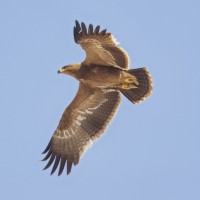Description
The staggering pink-and-white slopes of the Caucasus mountain foothills in the Khizi region have earned them the name of the “Candy Cane Mountains”. The area is known for several species of lower mountain habitats and it is a nice side trip during a spring visit to Besh Barmag or a drive between Baku and the Greater Caucasus Mountains. Among the birds you can encounter in the area are Szirti csuszka, Csukár, Kucsmás sármány, rőtfarkú fülemüle, Pusztai sas, Feldegg-sólyom, türk hantmadár, Pásztormadár, Szalakóta, vörösfejű gébics, Dögkeselyű, Black Vulture, Fakó keselyű and Fehérkarmú vércse.
Details
Access
One of Azerbaijan’s most beautiful stretches of road leads for about 40 kilometres from the Guba-Baku highway west towards the mountain village of Altiaghaj. Roughly mid-way between the two one passes through a dramatic valley flanked by rolling shale mountains whose astonishing red, orange, pink and chalk-coloured swirls led British travel writer Mark Elliott (author of the very popular 'Azerbaijan' guidebook) to dub them the Candy Cane Mountains, a name that’s stuck with travellers ever since. The astonishing colours are said to be due to groundwater that’s altered the oxidation state of iron compounds within the rock. If taking an organised hike here, which can be booked through tour companies in Baku and is preferably undertaken in autumn or spring, glance down beneath your feet: you may discover tiny fossils and perhaps even a squid-like belemnite from the cretaceous period.
Terrain and Habitat
Mountain , Scattered trees and bushes , Grassland , City/village , AgricultureConditions
Mountainous , Hilly , DryCircular trail
YesIs a telescope useful?
Can be usefulGood birding season
Spring , SummerBest time to visit
Summer , SpringRoute
Paved road , Wide pathDifficulty walking trail
StrenuousAccessible by
Foot , CarBirdwatching hide / platform
NoExtra info
The corridor between the mountains and the sea is a birdwatching site of global significance and you can climb from here to the top of Beshbarmag Mountain to witness stunning views and intriguing spiritual rituals.




